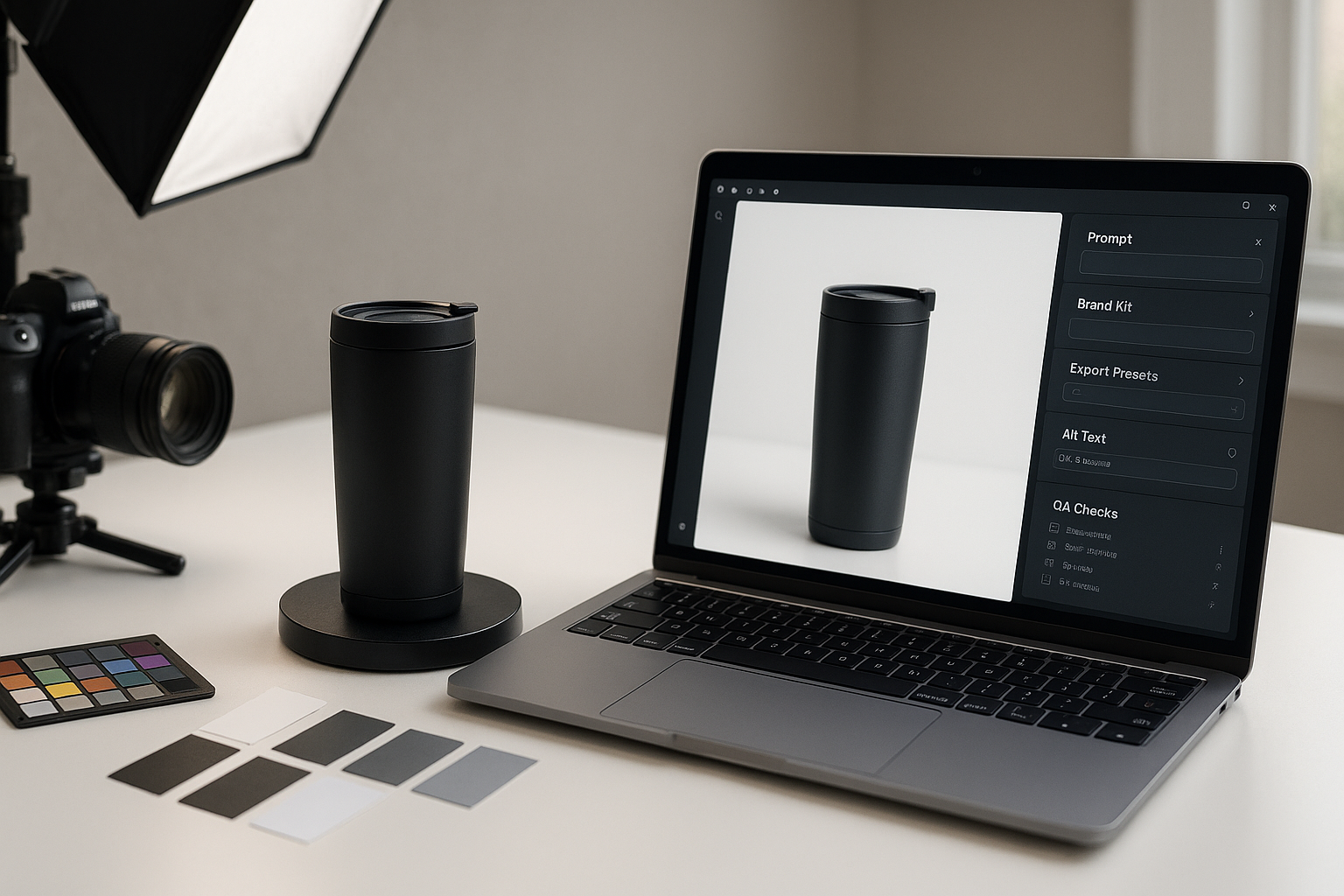How to Make Product Photos and Social Creatives with AI (Safely)
Studio look, startup speed. This guide gives you the prompts, policies, and presets to make product photos and social creatives with AI—accurate, on-brand, and ad-approved.

Who this is for: small teams that need studio-quality visuals fast—without risking brand, IP, or platform takedowns.
Outcome: a repeatable workflow to turn raw shots into on-brand product photos and social creatives, with legal and ethical guardrails baked in.
The 60-Minute Setup
- Assemble a mini brand kit
- Logo (SVG/PNG), hex colors, two typefaces, 5 reference images that “feel right.”
- A 1-paragraph voice/tone blurb (e.g., “clear, confident, minimal, no hype.”)
- Pick your safe tool stack
- Editing/Generation: Firefly/Photoshop GenAI, Canva, Figma, or Midjourney* (for concepting).
- Compositing/Retouch: Photoshop or Photopea.
- Batch & sizes: Canva/Figma, or an automation layer (Make/Zapier) for export presets.
*Use non-infringing prompts (details below).
- Create export presets (social-ready)
- IG Post 1080×1080; IG Reel/TikTok 1080×1920; LinkedIn 1200×627; X 1600×900; Story 1080×1920; Pinterest 1000×1500.
Guardrails That Keep You Out of Trouble
- No brand squatting: do not request or mimic 3rd-party brand styles, logos, or trademarked characters.
- No look-alikes: avoid prompts like “make it look like [famous brand/photographer/artist].”
- Rights-clean inputs: only use assets you own, licensed stocks, or generative assets with commercial rights from the provider.
- Consents on people: get model/property releases; use the platform’s consent tools when required.
- Truth in advertising: don’t depict product features that don’t exist.
- Platform checks: some ads reject “overly AI” artifacts; keep renders photoreal and product-accurate.
The Core Workflow (Repeatable)
- Capture a clean base
- Shoot the product on neutral background, soft light, multiple angles. Phone is fine; lock exposure; shoot RAW/HEIC if possible.
- Cut & Clean
- Remove background → light retouch (dust, edges) → realistic shadows (soft drop/grounded).
- Scene & Style (with prompts)
- Use your brand kit and safe prompts to set environment, mood, props—and keep the product accurate.
Prompt Starter: Product-on-White (Retail Ready)
“Create a photoreal studio shot of [product], centered on pure white background, soft even lighting, natural shadow under the product, lens 50mm, no logos or extra text. Maintain true proportions and surface texture.”
Prompt Starter: Lifestyle Context (Non-infringing)
“Place the [product] on a sunlit kitchen counter with soft window light and subtle depth of field. Add neutral props that suggest morning routine (mug, small plant). Keep composition minimal and modern. No branded items.”
Prompt Starter: Seasonal Variant
“Generate a subtle autumn setting: warm tones, blurred foliage bokeh, gentle backlight. Keep the [product] front and sharp; avoid cliché symbols (no trademarked characters).”
- Type & Layout
- Add concise headline (≤6 words), subline (≤12 words), single CTA. Use brand fonts and consistent grid.
- Export & QA
- Export preset sizes; compress (85–90% JPG or WebP).
- QA checklist: color drift vs. brand hex, artifact check (edges, hands, reflections), text legibility, thumbnail test at 15% size, rights check.
Safe Prompt Library (Copy/Paste + Fill Brackets)
- Shadow & Grounding: “Add a soft, realistic ground shadow under [product] matching a top-left key light; avoid halo edges.”
- Material Fidelity: “Preserve [matte metal / glossy plastic / woven fabric] texture; avoid plastic sheen; accurate color [HEX].”
- Reflection Control: “Subtle reflections on glossy surfaces; no mirror artifacts; no phantom logos.”
- Human Hands (Optional): “Include a hand holding [product], neutral manicure, natural skin texture, realistic joint angles, no extra fingers.”
- Background Swap: “Replace background with [location vibe—‘minimal studio, soft gray gradient’]; maintain product scale and native shadow.”
Social Creative Patterns That Convert
- Problem → Product → Proof
Frame 1: pain point in 5 words.
Frame 2: product hero + 1 benefit.
Frame 3: micro-proof (rating, short testimonial, ‘used by 1,243 customers’).
CTA: 2–3 words. - Before / After (Truthful)
- Show real improvement (e.g., cluttered desk vs. clean setup with product). No exaggerated claims.
- Color Swarm
- Same layout, 5 colorways side-by-side; text: “Pick your shade.” Boosts saves and shares.
- Micro-How-To
- Three steps overlayed on product photos. Keeps watch time up on Reels.
Accessibility & Performance
- Alt text: concise, literal: “Matte black 20oz tumbler with slide lid on white background.”
- Contrast: verify AA for text on images.
- File size: aim < 1 MB images, < 6 MB short video; keep fast load for ads and PDPs.
- A/B: test background (white vs. soft color), angle (45° vs. overhead), CTA verb, and headline length.
One-Week Rollout Plan
- Day 1: Brand kit, export presets, rights policy one-pager.
- Day 2: Shoot & clean 12 core SKUs (front, angle, detail).
- Day 3: Generate 3 lifestyle scenes per SKU (safe prompts).
- Day 4: Build social set: 1 product hero + 2 variants + 1 story for each SKU.
- Day 5: QA + compress + alt text + schedule posts.
- Day 6–7: Run $50 ad test per top 3 SKUs; measure CTR, CPC, saves. Iterate.
Metrics That Matter
- Creative efficiency: time from capture to publish (target: <45 min/asset).
- Unit economics: CAC change vs. last month.
- Engagement: saves, shares, outbound clicks per creative.
- Accuracy: % assets passing QA first time (target: 95%+).
- Rights incidents: should be zero.
Common Pitfalls (and Fixes)
- Plastic look: add subtle film grain; reduce AI “smoothness”; use real shadows.
- Color mismatch: soft-proof against hex; avoid heavy LUTs.
- Messy edges: refine mask; feather 0.5–1px; rebuild shadow.
- Text illegible on mobile: minimum 32–36px at 1080 width; high contrast.
- Infringing vibes: remove brand references, celebrity styles, or signature design cues.
Want this done for you?
Want to get started? Contact us today for a consult!
